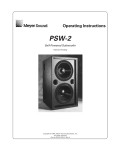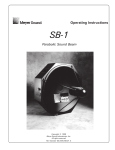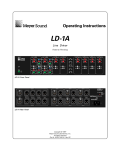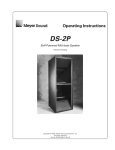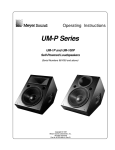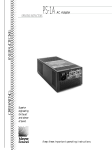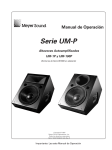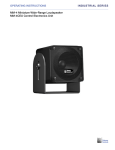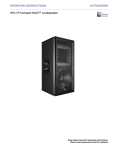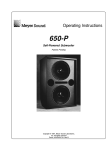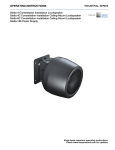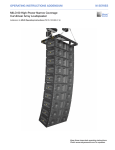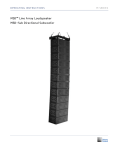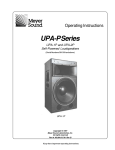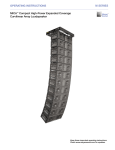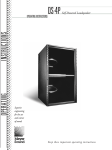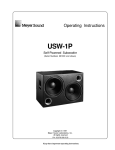Download Meyer Sound HM-1S Speaker System User Manual
Transcript
Operating Instructions HM-1S Self-Powered Studio Monitor Patents Pending Copyright © 1998 Meyer Sound Laboratories, Inc. All rights reserved Part # 05.059.004.01 Rev A2 Contents Introduction .......................................................... 3 Power Requirements ............................................ 3 Power Cable Requirements .................................. 5 Audio Input ........................................................... 5 The HM-1S Subwoofer ......................................... 5 Cooling and Fan Installation ................................ 16 Protection and Limiting ....................................... 16 Safety Summary ................................................. 17 Rear Panel Connectors ....................................... 18 Dimensions ......................................................... 18 Symbols Used These symbols indicate important safety or operating features in this booklet and on the chassis. ! Dangerous voltages: risk of electric shock Important operating instructions Frame or chassis Protective earth ground Pour indiquer les risques résultant de tensions dangereuses Pour indequer important instructions Masse, châssis Terre de protection Zu die gefahren von gefährliche spanning zeigen Zu wichtige betriebsanweisung und unterhaltsanweisung zeigen Rahmen oder chassis Die schutzerde Armadura o chassis Tierra proteccionista Para indicar azares provengo de peligroso voltajes Para indicar importante funcionar y mantenimiento instrucciones Declaration of Conformity According to ISO/IEC Guide and EN 45014 The Manufacturer: declares that the product: Name: Meyer Sound Laboratories Address: 2832 San Pablo Avenue Berkeley, California 94702-2204, USA Product Name: Product Options: HM-1S All conforms to the following Product Specifications: Safety: EMC: EN 60065: 1994 EN 55022: 1987 IEC 801-2: 1984 IEC 801-3: 1984 IEC 801-4: 1984 - Class A - 8 kV - 3 V/m - 0.5 kV Signal Lines, 1.0 kV Power Lines The product herewith complies with the requirements of the Low Voltage Directive 73/23/EEC and the EMC Directive 89/336/EEC. Office of Quality Manager Berkeley, California USA April 1, 1997 2 Environmental Specifications for Meyer Sound Electronics Products Operating temperature: 0° C to +45° C Nonoperating temp: < 40° C or > +75° C Humidity: to 95% at 35°C Operating altitude: to 4600 m (15,000 ft) Nonoperating altitude: Shock: on each of 6 sides Vibration: to 6300 m (25,000 ft) 30 g 11 msec half-sine 10 55 Hz (0.010 m peak-to-peak excursion) Introduction Power Requirements The Meyer HM-1S Studio Monitor is a compact, fullrange, self-powered reference monitor that employs a concentric tweeter mounting structure to achieve true point-source performance. Sophisticated phase-correction circuitry provides superb imaging without the off-axis cancellation effects, back-wave interference, and IM distortion commonly exhibited by dual-concentric speakers. The HM-1S requires a 48 VDC external power supply, which provides these benefits: The HM-1S Studio Monitor is a two-way system comprising a 7-inch graphite cone low-frequency driver, and a concentrically-mounted, 1-inch soft-dome high-frequency driver. A constant-directivity, high-frequency horn affords a symmetric 100° beam width. The HM-1S employs optimized electronics, drivers, and cabinet venting (tuned to 40 Hz) to achieve low frequency response far exceeding that of most small speakers. The drivers are magnetically shielded and the magnets employ field-cancelling techniques to minimize magnetic leakage, allowing speaker placement within one foot of color video monitors. The HM-1S can be used with the Meyer HM-1S Studio Subwoofer, extending the free-field LF (low frequency) response down to 42 Hz. The passive subwoofer is powered from the Sub output on the rear panel of the HM1S. Although each HM-1S Studio Monitor can power a subwoofer, ample LF energy may be obtained by driving one subwoofer from two HM-1S Studio Monitors, resulting in a correctly-summed mono signal. Subwoofer usage depends on the loading conditions, the LF gain desired, and whether a stereo LF signal is required. Placing the HM-1S next to a wall or ceiling (half-space loading) also extends the LF response down to 42 Hz. The HM-1S Studio Monitor and Subwoofer cabinets are constructed from medium density fiberboard and finished with an attractive, durable oak veneer (natural wood or black). Although external heatsinks on the rear of the cabinet provide adequate convection cooling, a variable-speed cooling fan assembly (part# 40.039.016.01, driven from a rear-panel output and mounted on the rear of the speaker) is available if the HM-1S will be operated in hot temperatures or in an unventilated, enclosed area. The enclosure contains a 400 W stereo amplifier, an active crossover, frequency and phase alignment circuitry, and driver protection voltage limiters. Front-panel LEDs indicate power, signal limit, and thermal overload, and a rearpanel circuit breaker provides overall DC power protection. Low voltage wiring simplifies installation. Utilizes telecom 48 V supply and bus standard. Eliminates 50/60 Hz AC noise coupling in wiring. The power supply input uses a male 2-pin EN3 connector. The HM-1S can be powered by the Meyer PS-1 AC adapter or a supply that conforms to the 48 VDC specifications detailed in this section. Meyer PS-1 AC Adapter Using the Meyer PS-1 AC adapter is the simplest way to power a pair of HM-1Ss, or a single HM-1S with a subwoofer. The AC adapter can be purchased through Meyer Sound and comes with two 10 ft power cables. The AC adapter has two output connectors that are wired together inside the supply, allowing either one connector to drive two speakers at the end of a single cable, or one connector and cable per speaker. Do not connect the outputs of multiple PS-1 AC adapters together! For installations up to 10 HM-1Ss, using multiple PS-1 AC adapters is often the simplest and most cost-effective solution. Since the limited output power for each supply acts as circuit protection for light gauge cables, it is not necessary to install circuit breaker distribution panels. Using the PS-1 does, however, limit each 48 V line to two speakers. The dimensions of the AC adapter are 10 x 5 x 3. Contact Meyer Sound for further information on the PS1 AC Adapter. ! Do not use a ground-lifting adapter or cut the AC cable ground pin. The HM-1S accepts a unipolar 48 VDC power source, which may be supplied by the Meyer PS-1 AC Adapter. Using a DC supply enables long power cable runs with minimal induced noise or hum, which is particularly important for recording studios and other noise sensitive environments. 3 Power Supplies for Larger Systems If an installation includes more than 10 speakers, or requires several speakers to operate from a single 48 V line, a single, high-output power supply should be considered. The following sections provide current and voltage specifications for the HM-1Ss power requirements. Current Ratings The wide dynamic range of audio signals normally causes a high peak-to-RMS ratio in an amplifiers DC supply currents. The HM-1S has internal storage circuits to minimize the peak-to-average ratio, which reduces the peak power rating required by the supply; allows efficient use of switched-mode power supplies which have similar peak and continuous ratings. The following table lists the current and power draw for a single HM-1S at light, moderate, and maximum operating levels. An HM-1S with subwoofer draws 0.4 ADC, 20 W in a quiescent state. Voltage Ratings The voltage operating range for the HM-1S is 48 VDC nominal, 52 VDC absolute maximum, and 35 VDC minimum without shutoff. Allowing operation down to 35 VDC provides two benefits. First, a moderate voltage drop (up to 8 V) for long DC power cables has a minimal impact on audio performance, enabling the use of light-gauge cables for most installations. Each HM-1S draws 0.4 ADC, 20 W in a quiescent state. The RMS current is measured over a 500 ms integration time. The peak current is measured over a 10 ms integration time. Each HM-1S can drive a slaved Meyer subwoofer from a connection on the amplifier panel. Adding the subwoofer increases the amplifiers output current, which increases the power supply current. The current and power ratings for an HM-1S and a subwoofer are listed in the following table at light, moderate, and maximum operating levels. 4 Second, since some switched-mode power supplies slowly foldback the voltage if they experience currentlimit, power supplies with lower power (current) ratings can be used efficiently. Since supplies with lower power ratings typically experience current-limit when the HM1S is at continuous limiting, some voltage drop and loss of headroom is acceptable provided the voltage does not drop below 35 VDC. At 35 V, the maximum current draw is 25% lower than the values stated in the preceding tables. NOTE: If the HM-1S will not be driven at continuous limiting, a power supply that satisfies the moderate specifications for voltage and current can be used safely without risk of sonic degradation or interruption. It is important to understand how the selected power supply responds to current-limit, particularly for switchedmode supplies. Some supplies trip off and must be reset manually, while others remain off for a period of time and reset automatically. In both cases, the HM-1S suffers audio interruption. In the third, and preferable case, supplies that feature voltage foldback allow brief periods of current-limit without audio interruption; for this reason, we recommend using such supplies. A single HM-1S attached to a 100 ft 18 AWG cable (1.27 Ω total) produces a 6.4 VDC loss at the speaker (41.6 V) during maximum audio bursts (5 A, 0.5 s). This results in a small loss in peak SPL. The HM-1S does not require tight voltage regulation and operates down to 35 V although peak SPL values are reduced. This operating voltage flexibility allows for wiring loss and voltage foldback without interruption or degradation of the audio signal. Audio Input Many high power industrial supplies (15 kWatt) are available for 19 EIA racks that are suitable for large installations with equipment rooms. Distribution panels with branch circuits can be used economically with up to 8 HM-1Ss on a branch. Contact Meyer Sound for information on tested and approved supplies. The HM-1S has an input impedance of 10 kΩ and receives its audio input signal at a female XLR connector. Pins 2 and 3 carry the input as a differential signal; pin 1 and the case are connected to the chassis. The power and audio cables can be jacketed in the same sheath without inducing noise to the input signal. Power Cable Requirements For best EMI immunity, it is desirable to use a twisted pair shielded cable with the twisted pair connected to pins 2 and 3, and the shield to pin 1. However, an unshielded twisted pair cable can be used effectively, even if it is jacketed with the power cable. Each HM-1S draws a maximum of 3 Arms and 5 Apk from a 48 V power supply at peak SPL. The cabling between the 48 V supply and the speaker adds resistance to the circuit and produces a voltage drop at the speaker. Decreasing the voltage at the speaker compromises the peak SPL so cable resistance should be minimized. For best sonic performance, avoid voltage drops greater than 8 V at the speaker. Voltage drops greater than 15 V may cause the speaker to mute or distort. The maximum round-trip resistance for a cable attached to a single HM-1S should be no higher than 1.6 Ω, which keeps the voltage drop below 8 V during the maximum current draw of 5 Apk. The following table helps select cable gauges for various cable lengths. The input is RF and ESD protected, capacitive coupled, ±50 V common mode to ground, +4 dBu nominal, +21 dBu max. Clipping occurs at the input at 12 Vpk. The Common Mode Rejection Ratio (CMRR) is greater than 80 dB. The HM-1S Subwoofer The low frequency response of an HM-1S can be extended down to 42 Hz if used with the HM-1S Subwoofer or placed next to a wall or ceiling (half-space loading). Each HM-1S can power a subwoofer from the male 3-pin EN3 Sub output connector on the rear panel. However, depending on the loading conditions, ample low frequency energy may be obtained by driving a single subwoofer from two HM1Ss, resulting in a correctly-summed mono signal. Cables for connecting one HM-1S to a subwoofer and two HM-1s to a single subwoofer are shipped with each HM-1S Subwoofer. The addition of one subwoofer increases the maximum SPL of a single HM-1S by 4 dB (without sub: 116 dB SPL; with sub: 120 dB SPL). The HM-1S Subwoofer has the following specifications: Transducer 10 low frequency cone driver Enclosure/Finish Medium Density Fiberboard (MDF) / Oak Veneer (natural or black) Weight 33 lb (11.0 kg) Dimensions Height: 17.5; Width: 12.3; Depth: 9.3 5 HM-1S Speaker Cable The following drawings and procedures are provided as an aid in the event that the speaker cable used to connect the HM-1S to the HM-1S Subwoofer needs to be repaired or extended. In cases where the original speaker cable has been modified, be sure to complete the Subwoofer Performance Verification section on page 10 of this manual. Misalignment of the polarity between the HM-1S and the HM-1S Subwoofer will result in a serious degradation of performance. (Single HM-1S to HM-1S) Stereo Subwoofer Cable M.S.P.N. 28.062.007.01 (2 HM-1S to 1 HM-1S) Mono Subwoofer Cable M.S.P.N. 28.062.009.01 Connections: Gray wire to pin 1, pin 2 no connection, pin 3 no connection. GRAY - Connections: Gray wire to pin 1, pin 2 no connection, White wire to pin 3. Connections: pin 1 no connection, pin 2 no connection. White wire to pin 3. + 6 WHITE HM-1S to HM-1S Subwoofer Cable Connector Assembly Procedure Boot Coupling Ring Cable Cable Clamp Housing Cord Connector Contact Pins Step 1: Feed the end of the cable through the boot, cable clamp housing, and coupling ring in the order and position shown. Cord Connector Cable Dot pin 1 indicator 3/8" Max. Solder 3 1 1 7/32" 2 Contact Pins 3 9/32" Step 2: FOR STEREO CABLES: Strip cable as shown and begin soldering conductors to pins starting with the Gray wire to pin 1, pin 2 no connection, and the White wire to pin 3. FOR MONO CABLES: See wiring instructions on page 6. Cord Connector Cord Connector Tab Coupling Ring Tab Side notch Step 3: Align coupling ring's tabs with cord connector's side notches and push the coupling ring onto cord connector. Clamp Step 4: Clamp Lock Push the cable clamp housing foward until it locks into the connector body and snap the two clamps into their compartments. Step 5: Push the boot all the way foward to seat tightly onto the cable clamp housing. 7 Subwoofer Performance Verification There are two methods of verifying that the phase relationship between the HM-1S and its subwoofer. One method is free field, the other is a ground plane measurement in half space. Free Field: Place the HM-1S directly above and coplanar to the subwoofer as pictured below: Place a calibrated measurement microphone 1 meter, on axis to the tweeter of the HM-1S as pictured below: Using the noise or other broadband test signal, perform a transfer function of the HM-1S. Start with the subwoofer disconnected. 8 HM-1S on axis at 1 meter, free field. This represents a typical response of the HM-1S in free-field environment, on axis at 1 meter. This measurement was performed in the large anechoic chamber at MSLI. Connect the subwoofer and measure the combined response of the system. 9 HM-1S with in-phase subwoofer on axis at 1 meter, free field. This represents a typical response of the HM-1S and subwoofer, in phase, in a free field environment on axis at 1 meter. This measurement was performed in the large anechoic chamber at MSLI. This response indicates a complementary phase relationship between the HM-1S and subwoofer. 10 If the subwoofer is out of phase, the combined response will have a significant loss of energy compared to the overall response at around 82 Hz as illustrated below: HM-1S with out-of-phase subwoofer on axis at 1 meter, free field. 11 This represents a typical response of the HM-1S and subwoofer out-of-phase phase, in a free field environment onaxis at 1 meter. This measurement was performed in the large anechoic chamber at MSLI. If your system response indicates a phase reversal please contact Meyer Sound Technical Support for assistance. Half Space: To verify the system performance in half space you must perform a ground-plane measurement. This type of measurement is not desirable for system calibration and should only be used to verify the performance of the subwoofer. Place the HM-1S next to the subwoofer on the flat ground and position the calibrated measurement microphone one meter on axis from the tweeter of the HM-1S as pictured below: Using noise or other broadband test signal, perform a transfer function of the HM-1S. Start with the subwoofer disconnected. 12 HM-1S on axis at 1 meter, ground plane. This represents a typical ground-plane response of the HM-1S, on-axis at 1 meter. Keep in mind that any surface close to the test space can create reflections which will change the response of the speaker. Connect the subwoofer to the HM-1S and measure the combined response of the system. 13 HM-1S with in-phase Subwoofer on axis at 1 meter, ground plane. This represents a typical ground-plane response of the HM-1S and subwoofer, in phase, at 1 meter. This response indicates a complementary phase relationship between the HM-1S and subwoofer. 14 If the subwoofer is out of phase the combined response will have a significant loss of energy compared to the overall response at around 82 Hz as illustrated below: HM-1S with out-of-phase Subwoofer on axis at 1 meter, ground plane. This represents a typical ground plane response of the HM-1S and subwoofer out-of-phase, in a ground plane environment on axis at 1 meter. If your system response indicates a phase reversal please contact Meyer Sound Technical Support for assistance. 15 Cooling and Fan Installation The HM-1S depends on natural convection to cool the heatsinks that absorb heat from the amplifiers and radiate the heat into the surrounding air space. Natural convection requires free air in back of, and underneath the HM-1S to allow air to flow up over the heatsinks. The HM-1S reaches an equilibrium temperature in approximately 15 minutes at a steady operating level. In free air, at a typical room temperature of 25°C, the HM1S reaches an equilibrium temperature of 40°C in a quiescent state (no audio signal); 60°C at a moderate operating level (occasional limiting); 75°C at the maximum operating level (continuous limiting), or at a moderate level with a subwoofer. If the temperature reaches 85°C, the thermal limiters activate (see Protection and Limiting) to prevent high source levels from further increasing the temperature and damaging the drivers and electronics. The thermal limiters provide 30 dB of muting until the temperature decreases to 75°C. The HM-1S can be cooled by two fans, available as an accessory kit. The fans should be used if: the HM-1S is enclosed in a soffit or ceiling mount without adequate space for natural convection; the HM-1S is used in hot ambient temperatures or direct sunlight; the user wishes to avoid accidental contact with the heatsinks if the rear of the HM-1S is exposed. The fans attach easily to the two bottom rear corners of the HM-1S. Use a 5/32 Allen wrench to remove the bottom screws and install the left and right fans according to the diagram below. The fans are shipped with a terminal plug keyed for insertion into the 2-pin fan output connector in the proper orientation only. The fan speed is temperature controlled. At a heatsink temperature of 25°C, the fans turn on at half speed and increase speed linearly until reaching full speed at 75°C. Protection and Limiting The front of the HM-1S has two LEDs that indicate power and limiter activity. The right LED is green when power is applied. This LED turns red if thermal limiting occurs (described in the section Cooling and Fan Installation) until the temperature decreases to 75°C. The left LED indicates driver limiter activity with a variable intensity red color; full illumination occurs at thermal limiting. Rigging ! Do not drill into the HM-1S Cabinet. The HM-1S is not designed for use with rigging systems. For rigging needs, Use the Standard Contractors version HM-1 cabinets which can be easily fitted for omni- mounts, and other rigging options. Installed fans blow air over the heatsink 16 Safety Summary English ! Français To reduce the risk of electric shock, disconnect the loudspeaker from the AC adapter before installing audio cable. Reconnect the adapter only after making all signal connections. Pour réduire le risque délectrocution, débranchez la prise principale de lhaut-parleur, avant dinstaller le câble dinterface allant à laudio. Ne rebranchez le bloc dalimentation quaprès avoir effectué toutes les connections. Connect the AC adapter to a two-pole, three wire grounding mains receptacle. The receptacle must be connected to a fuse or circuit breaker. Connection to any other type of receptacle poses a shock hazard and may violate local electrical codes. Branchez lhaut-parleur dans une prise de courant à 3 dérivations (deux pôles et la terre). Cette prise doit être munie dune protection adéquate (fusible ou coupe-circuit). Le branchement dans tout autre genre de prise pourrait entraîner un risque délectrocution et peut constituer une infraction à la réglementation locale concernant les installations électriques. Do not install the loudspeaker in wet or humid locations. Do not allow water or any foreign object to get inside the loudspeaker. Do not put objects containing liquid on, or near, the unit. To reduce the risk of overheating the loudspeaker, avoid exposing it to direct sunlight. Do not install the unit near heat emitting appliances, such as a room heater or stove. This loudspeaker contains potentially hazardous voltages. Do not attempt to disassemble the unit. The unit contains no user serviceable parts. Repairs should be performed only by factory trained service personnel. Deutsch Ne pas installer lhaut-parleur dans un endroit où il y a de leau ou une humidité excessive. Ne pas laisser de leau ou tout objet pénétrer dans lhautparleur. Ne pas placer de r´cipients contenant un liquide sur cet appareil, ni à proximité de celui-ci. Pour éviter une surchauffe de lhaut-parleur, conservez-la à labri du soleil. Ne pas installer à proximité dappareils dégageant de la chaleur tels que radiateurs ou appareils de chauffage. Ce haut-parleur contient des circuits haute tension présentant un danger. Ne jamais essayer de le démonter. Il ny a aucun composant qui puisse être réparé par lutilisateur. Toutes les réparations doivent être effectuées par du personnel qualifié et agréé par le constructeur. Español Um die Gefahr eines elektrischen Schlages auf ein Minimum zu reduzieren, den Lautsprecher vom Stromnetz trennen, bevor ggf. ein Audio-Schnittstellensignalkabel angeschlossen wird. Das Netzkabel erst nach Herstellung aller Signalverbindungen wieder einstecken. Para reducir el riesgo de descarga eléctrica, desconecte de la red el altoparlante antes de instalar el cable de señalización de interfaz de la segnale. Vuelva a conectar el conductor flexible de alimentación solamente una vez efectuadas todas las interconexiones de señalizatción. Der Lautsprecher an eine geerdete zweipolige DreiphasenNetzsteckdose anschließen. Die Steckdose muß mit einem geeigneten Abzweigschutz (Sicherung oder Leistungsschalter) verbunden sein. Der Anschluß der unterbrechungsfreien Stromversorgung an einen anderen Steckdosentyp kann zu Stromschlägen führen und gegen die örtlichen Vorschriften verstoßen. Conecte el altoparlante a un tomacorriente bipolar y trifilar con neutro de puesta a tierra. El tomacorriente debe estar conectado a la protección de derivación apropiada (ya sea un fusible o un disyuntor). La conexión a cualquier otro tipo de tomacorriente puede constituir peligro de descarga eléctrica y violar los códigos eléctricos locales. Der Lautsprecher nicht an einem Ort aufstellen, an dem sie mit Wasser oder übermäßig hoher Luftfeuchtigkeit in Berührung kommen könnte. Darauf achten, daß weder Wasser noch Fremdkörper in das Innere den Lautsprecher eindringen. Keine Objekte, die Flüssigkeit enthalten, auf oder neben die unterbrechungsfreie Stromversorgung stellen. Um ein Überhitzen dem Lautsprecher zu verhindern, das Gerät vor direkter Sonneneinstrahlung fernhalten und nicht in der Nähe von wärmeabstrahlenden Haushaltsgeräten (z.B. Heizgerät oder Herd) aufstellen. Im Inneren diesem Lautsprecher herrschen potentiell gefährliche Spannungen. Nicht versuchen, das Gerät zu öffnen. Es enthält keine vom Benutzer reparierbaren Teile. Reparaturen dürfen nur von ausgebildetem Kundenienstpersonal durchgeführt werden. No instale el altoparlante en lugares donde haya agua o humedad excesiva. No deje que en el altoparlante entre agua ni ningún objeto extraño. No ponga objetos con líquidos encima de la unidad ni cerca de ella. Para reducir el riesgo de sobrecalentamiento, no exponga la unidad a los rayos directos del sol ni la instale cerca de artefactos que emiten calor, como estufas o cocinas. Este altoparlante contiene niveles de voltaje peligrosos en potencia. No intente desarmar la unidad, pues no contiene piezas que puedan ser repardas por el usuario. Las reparaciones deben efectuarse únicamente por parte del personal de mantenimiento capacitado en la fábrica. 17 Rear Panel Connectors Audio Input Signal (female XLR) 6A Fan Output (2-pin terminal plug) Circuit Breaker Dimensions All units in inches HM-1S Front HM-1S Side HM-1S Top HM-1S Sub Front HM-1S Sub Side HM-1S weighs 11.0 lb (5.0 kg); HM-1S Subwoofer weighs 33 lb (15 kg) Meyer Sound Laboratories, Inc. 2832 San Pablo Avenue Berkeley, California 94702 Telephone: 510 - 486 - 1166 FAX: 510 - 486 - 8356 E-mail: [email protected] http://www.meyersound.com 18 Meyer Sound Germany GmbH Carl Zeiss Strasse 13 D-56751 Polch Germany Telephone: 26 54 96 00 58 FAX: 26 54 96 00 59 E-Mail: [email protected]


















